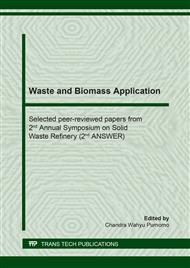[1]
Saxena R.K., Anand P., Saran S., Isar J., Microbial production of 1,3-propanediol: recent developments and emerging opportunities, Biotechnol Adv. 27 (2009) 895–913.
DOI: 10.1016/j.biotechadv.2009.07.003
Google Scholar
[2]
Katryniok B., Paul S., Dumeignil F., Recent developments in the field of catalytic dehydration of glycerol to acrolein, ACS Catal. 3 (2013) 1819–34.
DOI: 10.1021/cs400354p
Google Scholar
[3]
Izquierdo JF, Montiel M, Pales I, Outon PR, Galan M, Jutglar L, et al, Fuel additives from glycerol etherification with light olefins: state of the art, Renew Sustain Energy Rev. 16 (2012) 6717–24.
DOI: 10.1016/j.rser.2012.08.005
Google Scholar
[4]
Decolatti H.P., B.O. Dalla Costa, C.A. Querini, Dehydration of glycerol to acrolein using H-ZSM5 zeolite modified by alkali treatment with NaOH, Microporous and Mesoporous Materials 204 (2015) 180-189.
DOI: 10.1016/j.micromeso.2014.11.014
Google Scholar
[5]
Abdullah A., Elena F. K., Ivan V. K., Gas-phase dehydration of glycerol to acrolein catalyzed by caesium heteropoly salt, Applied Catalysis A:General 278 (2010) 11-18.
DOI: 10.1016/j.apcata.2010.01.043
Google Scholar
[6]
Amin T-K, Nor A. S. A., Hadi H., Glycerol for renewable acrolein production by catalytic dehydration, Renewable and Sustainable EnergyReviews 40 (2014) 28-59.
DOI: 10.1016/j.rser.2014.07.168
Google Scholar
[7]
Ingvi G., Stefan A., Treatment of Geothermal Waste Water to Prevent Silica Scalling, Proceedings World Geothermal Congress (2005).
Google Scholar
[8]
Ed Mroczel, et. al., From Waste to Wealth : Mineral Etraction from Geothermal Brines, Proceedings World Geothermal Congress (2015).
Google Scholar
[9]
Widayat et. al., Synthesis of Zeolite X Molecular Sieve from Geothermal Solid Waste, Material Today : Proceedings 13 (2019) 137-12.
DOI: 10.1016/j.matpr.2019.03.203
Google Scholar
[10]
Masoume D. M., Seyed N. A., & Shahram G. 2016. The synthesis of analcime zeolite nanoparticles using silica extracted from stem of sorghum Halepenesic ash and their application as support for electrooxidation of formaldehyde. International Journal of Hydrogen Energy, pp.1-12.
DOI: 10.1016/j.ijhydene.2016.08.181
Google Scholar
[11]
Hay R. L., Zeolites and Zeolitic Reactions in Sedimentary Rocks, Dept. Geology and Geophysics, University of California, Berkeley, California, (1966).
Google Scholar
[12]
Masoume D. M., Seyed N. A., Shahram G., The synthesis of analcime zeolite nanoparticles using silica extracted from stem of sorghum Halepenesic ash and their application as support for electrooxidation of formaldehyde, International Journal of Hydrogen Energy (2016) 1-12.
DOI: 10.1016/j.ijhydene.2016.08.181
Google Scholar
[13]
Martens, et. al., Amorphous Microporous Mixed Oxides as Selective Redox Catalysts, Catalysis Letters 38 (1996) 209-214.
DOI: 10.1007/bf00806570
Google Scholar
[14]
Widayat, Dionisius A., Izmi N., Preparation of α-Fe2O3-Al2O3 Catalysts and Catalytic Testing for Biodiesel Production, Material Todays : Proceedings 13 (2019) 97-102.
DOI: 10.1016/j.matpr.2019.03.195
Google Scholar
[15]
Bimo T.D., Sriatun, Taslimah, Sintesis SIlika Kristalin Menggunakan Surfaktan Cetiltrimetilamonium Bromida (CTAB) dan Trimetilamonium Klorida (TMACI) sebagai Pencetak Pori, Jurnal Kimia Sains & Aplikasi 11 (2008).
DOI: 10.14710/jksa.11.1.20-28
Google Scholar
[16]
A.Galadima & O. Muraza, A Review on Glycerol Valirozation to Acrolein over Solid Acid Catalysts, Journal of the Taiwan Institute of Chemical Engineers 67 (2016) 29-44.
DOI: 10.1016/j.jtice.2016.07.019
Google Scholar
[17]
Dostert KH, et.al., Adsorption of Acrolein, Propanal, and Allyl Alcohol on Pd(111): a Combined Infrared Reflection-Absorption Spectroscopy and Temperature Programmed Desorption Study, Phys. Chem. 18 (201^) 13960-13973.
DOI: 10.1039/c6cp00877a
Google Scholar
[18]
Chun-Jiang Jia, et.al., Small-sized HZSM-5 Zeolite as Highly Active Catalyst for Gas Phase Dehydration of Glycerol to Acrolein, Journal of Catalysis 269 (2010) 71-79.
DOI: 10.1016/j.jcat.2009.10.017
Google Scholar



